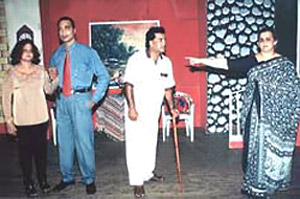 Konkani theatre exhibits a motley picture of indigenous as well as alien generic repertoires in a multi-lingual or cultural situation. This includes a rich folk tradition of Dasavatar, Lalit, Jagar, and Gavalankalo among Hindus, and Tiatr, Phel and even drama in English by Christians complicate the scene. The retrieval in 1989 of Godde Ramayanand of manuscripts in Roman script from archives in Portugal, demonstrates how theatre itself became a cultural battlefield. Godde Ramayan was a medieval Konkani folk play in Malayalam script.
Konkani theatre exhibits a motley picture of indigenous as well as alien generic repertoires in a multi-lingual or cultural situation. This includes a rich folk tradition of Dasavatar, Lalit, Jagar, and Gavalankalo among Hindus, and Tiatr, Phel and even drama in English by Christians complicate the scene. The retrieval in 1989 of Godde Ramayanand of manuscripts in Roman script from archives in Portugal, demonstrates how theatre itself became a cultural battlefield. Godde Ramayan was a medieval Konkani folk play in Malayalam script.
The intermixture of Marathi and Konkani is well illustrated by the unique contribution of the Mochangadkar Dasavatari Mandali. That was a bilingual troupe. It is also interesting to study comparatively the rise of modern drama in British Bombay and Portuguese Goa. Portuguese rule was not favourable to the development of drama in Goa, yet the elite theatrical performances in Portuguese, Spanish, and French from the seventeenth to the nineteenth century in Goa paved the padi for acculturation in the theatre. On the other hand, whatever was performed in the name of Tiatr in Konkani in the 1890s and later scripted in `Romi` by Goan migrants to Bombay was imitative of the British colonial theatre. Translations and adaptations of Western texts brought about the literary renaissance in Indian theatre, but this process started rather late in Konkani. When Shenoi Goembab in 1877-1946 adapted Moganche lagna i.e. `Love Marriage` in 1931 from Moliere`s A Doctor in Spite of Himself, it marked the real beginning of modern Konkani drama. He had earlier adapted Shakespeare in 1914, Moliere`s The Miser as Povananche taplne i.e. `Pot of Gold Coins` in 1926, and based Zilaba Rano on the Arabian Nights. The plays of Ramchandra Naik during 1893-1960 are also adaptations of European farces, except for Chavathicha chandra i.e. `Fourth-day Moon` in 1935. This is an original comic one-act drama that drew heavily on indigenous dialects and hybrid languages used in Goa. Among later full-length comedies, Pundalik Dande`s Tachi karamat i.e. `His Miracle` in 1956 is a significant social satire.
Theatre is a public art, and its development owes much to spectators. But the number of Konkani speakers is limited and their tastes differ from region to region. Nevertheless, contemporary Konkani theatre has tried to keep abreast in experimentation by adapting mainly European plays. For example, Suresh Borkar turned to Albert Camus`s Caligula, A. N. Mhambre freely adapted Eugene Ionesco`s The Bald Prima Donna, Dilip Borkar`s Vargasatrti i.e. `Class Enemy` is based on Ibsen`s `An Enemy of the People`. His Bharatebhar i.e. `High-tide Burden` in 1982 depicts current educational problems. N. Shivadas`s Pisat i.e.
`Manic-depressive` in 1978 was a bold attempt at portraying psychological problems in women. The twin processes of Westernization and Sanskritization gave rise to a tug of war in Konkani theatre too. But the latter force always remained weaker. The plays of Shantaram Hedo in 1950 mostly adaptations, demonstrate how oriental and occidental traditions of drama are juxtaposed. He rendered Portuguese as well as Sanskrit plays into Konkani. His Almaid Garre, Frier Louis D`Souz, and Madhalodut i.e. `Cloud Messenger`, based on Kalidasa`s Meghadut illustrate colonial culture contact in the theatre. These cross-cultural encounters were often mutually beneficial in vitalizing both Hindu and Christian theatrical activities. For example, Boxttench thapott marinakai i.e. `Don`t Slap without Reason` in 1995 by Lambert Mascarenhas contains cantatas just like a Christian Tiatr. It is also the only Indian play that depicts the Goan peasant`s life from a nativistic point of view. Thus its structure is alien, but its language is typically indigenous.
Adaptations of renowned Indian plays have enriched recent Konkani drama. Prakash Thali who was an actor, director, and writer both in Marathi and Konkani, adapted Sagina Mahato, Ajibpurbi kalpkatha i.e. `Fantastic Tale of a Strange City`, and other works in his collection titled Tin kheti shannisurti i.e. `Three Wise Monkeys` in 1987. Historical drama is slowly developing in this comparatively young theatre, under Ramkrishna Juwarkar, known for such plays as Bhagirathi in 1970, Amache rajya i.e. `Our Rule` in 1971, and Anvalakht i.e. `Strange Unknown` in 1975.
Mumbai is the centre from where new dramatic trends usually spread all over Goa. Marathi plays, as for instance by the Goa Hindu Association of Mumbai are regularly staged in Goa. The Saraswati Natya Mandal was founded by Konkani speakers in Mumbai. This interface still forms the link between Konkani theatre and theatre outside, revealing the continuing derivativeness of the former. The most original synthesis of popular and modern Goan theatrical traditions is exhibited in the dramatic works of Pundalik Narayan Naik.




